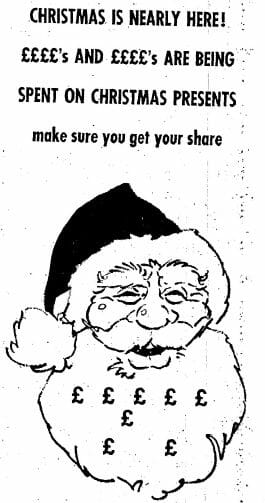| By James Alex Waldron, Marketing Communications Manager |
When we covered The Commercialisation of Christmas last year, hundreds of you followed the story of how advertising shifted the mood of the season from religious festival to retail bonanza.
As 2016 became the year of smartphone projectors, Bluetooth headphones, and Minion Pie Faces, I used Gale Primary Sources to provide the next part in our story of evolving buying habits. Following the reflections in the Press to provide part two — from early private brand announcements to full-page menus of big-ticket goods. What happened when the retailers themselves pushed gifts that necessitated new ways to pay.
Woolworths (1909-2009) was a general merchandise British retailer that in its later years, became known for making two-thirds of its total yearly sales over the festive season alone. In the late 1950s and well into the 1960s, the products featured in their Christmas advertising were increasingly re-positioned from food discounts to mid-market gifts.

It’s also worth noting as the value and mid-market retailers took up more nation-wide Christmas campaigns, brand-name manufacturers reacted with the advantage of tie-ups. In previous years Airfix would have taken their own adverts in the national press. As seen in the Daily Mail, Airfix has optioned the bottom corners of this Woolworths ad. It’s worth noting the range shows mechanised toys were still sought after, with dolls to ‘fall in love with’ and Batman’s Batcopter ready to ‘beat the baddies’.
Come the 1970s, Britain found value and mid-market retailers were pushing for spending to increase – nudging the range from ‘toiletries gift sets’ up to radio controlled cars and ‘Real Leather Gifts’.



Daily Mail (London, England), Saturday, November 27, 1976; pg. 13; Issue 25036.
Creating an increased demand on disposable incomes, the Daily Telegraph told of a potential problem in Britons spending their 1978 tax rebates, and not adding to their savings.

Retailers seemed to know expensive gifts had arrived and the way to pay was to ‘spread the cost of spreading goodwill’ – with charge accounts and bank-issued credit cards beginning to appear alongside seasonal advertising.

For context; the first credit card had been issued by Barclays in 1966 and the new Consumer Credit Act of 1974 provided an air of legitimacy in protecting against sub-standard goods, fraud and missing deliveries up to the tune of £10,000.[1]
Changing products
By the end of the decade however, the products had disappeared from some adverts altogether, with discounter Woolworths making an appearance with their own credit offer.

And in some instances, the credit was the gift with this Burton Group ‘Ready Credit’ offer intimating you could give a friend up-to £144 (£577 in 2016) instantly.[2]


A Press awakens
By the 1980s, personal consumer electronics had arrived;

With these greater gadgets for the home came greater credit limits; seen here with an instant Debenhams ‘Budget Account’ of £240 (£720 in 2016).


However debt awareness was relegated to the opinion pages.

The 1990s brought technological breakthroughs and prices to match with single gifts now running into hundreds of pounds. Again, the store featured is value to mid-market.

A confused picture
Perhaps knowing that a fresh generation of the British Public was now pre-programmed to spend big during the Christmas season, the 1990s and 2000s saw the press change tack, with lifestyle editorials telling you ‘how to spend it‘ – then appear to tap a collective buyer’s remorse.

The Times (London, England), Saturday, December 31, 1994; pg. 27; Issue 65152.


With retailers minded of a negative public awareness, they scaled-back their credit advertising. Now came a fightback from the lenders themselves. Seen here in The Independent on Sunday, the brokers offer incentives direct to shoppers. Here is the Co-operative Bank with their offer advert, under the umbrella brand message ‘Customer-led, ethically guided‘;


The Independent on Sunday (London, England), Sunday, November 14, 2004; pg. 10; Issue 769.
It was now the newsrooms took an overall different stance to their fellow sunday supplements. ‘Christmas debt’ had finally made it to the news pages; and even back into the opinion pieces.



It’s possible to leave a readership confused when you’re publishing what is essentially the same story – from opposite ends of the telescope. In the most part an angle was formed whether the story is published before or after the Christmas buying season. With the estimated UK combined spend for Christmas 2016 at £33,635,076,420 it’s perhaps unsurprising one in five of us will take three months or more to meet their debts.[3]

Clare Francis The Independent (London, England),Saturday, January 02, 2010; pg. 42; Issue 7246.
It appears the annual ‘how to pay for it’ stories are here to stay – alongside the perennial spreads for New Year’s January diet plans.
Blog post cover image citation: Christmas gift guide. The Times (London, England),Tuesday, Dec 02, 1975; pg. 23; Issue 59567.
[1] http://www.theukcardsassociation.org.uk/history_of_cards/index.asp
[2] http://www.moneysorter.co.uk/calculator_inflation2.html#calculator
[3] http://www.nationwide.co.uk/about/media-centre-and-specialist-areas/media-centre/press-releases/archive/2016/11/21-christmas-spending


